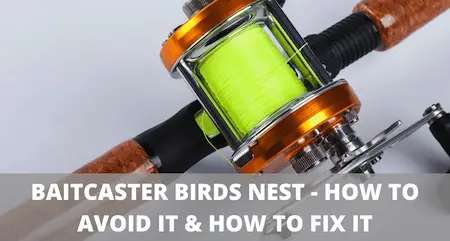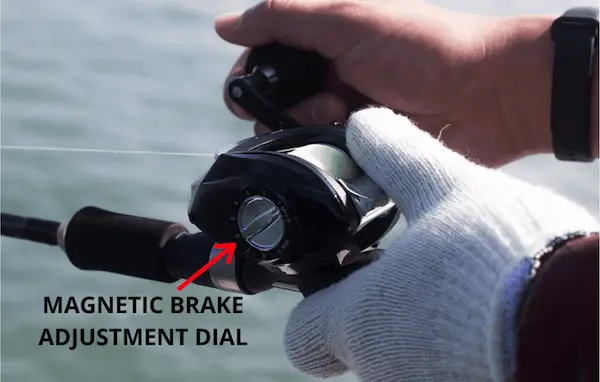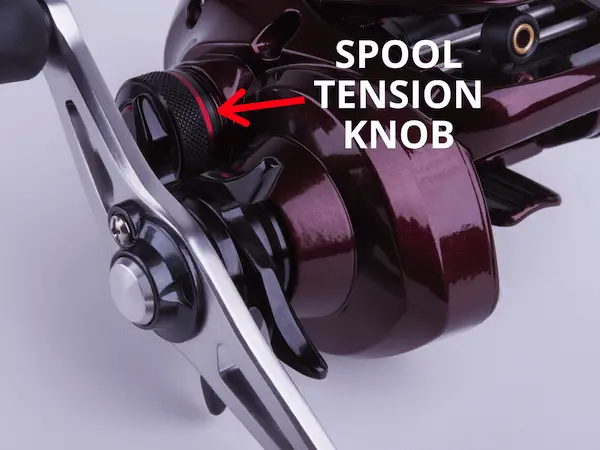Baitcaster Birds Nest – How To Avoid It And How To Get Rid Of It Quickly
UPDATED 08 MAY 2023
by Robert Ceran
While baitcasters are one of the most popular types of fishing reels, they are also the hardest to master, especially for beginners.
The main reason for this is that baitcasting reels easily generate backlash, which can lead to birds nest formation.
There are two things you can do to eliminate baitcaster birds nests:
- Learn how to cast a baitcaster without backlash
- Learn how to remove a baitcaster birds nest quickly if backlash does occur

In this guide we’ll walk you through the steps to do both of these.
What causes backlash?
When you cast a lure with your baitcaster, this triggers the spool of the reel to start rotating rapidly after you press down the thumb bar (which releases the clutch). This is all well and good, as you want the spool to release line for the cast.
However, the problem arises when the spool rotates faster than the lure pulls line away from it. In that case the spool throws off line too fast, and this line doesn’t get pulled off fast enough, which then results in backlash and birds nesting.
There are many reasons why this can happen, some of which you can control (such as the settings on your reel), and some of which you can’t (such as an unexpected head wind slowing down your lure in the air).
How to cast a baitcaster without birdnesting
In order to prevent baitcaster birds nest formation, you have to avoid backlash during the casting process.
And in order to achieve this, it’s essential to learn how to slow down spool rotation during the cast, so that it never throws off more line than is being pulled by the lure.
There are three main ways to slow down spool rotation on a baitcasting reel:
- Braking system
- Spool tension
- Thumb pressure
In order to prevent baitcaster birds nest, you need to master all three of these.
First of all, make sure that you understand the most important baitcaster reel parts, so that you’ll know how to use them correctly.
Secondly, make sure you know how to spool a baitcaster without introducing line twist.
This step is important since line twist introduced during the spooling process can cause birds nesting once you start casting with the reel.
Once you’ve made sure that you have spooled your baitcaster correctly, the next line of defence against backlash is to adjust the braking system on your baitcasting reel.
There are two types of baitcaster brakes: centrifugal and magnetic. Some baitcasters only have one of these, while most models now have both, which is better for preventing backlash.
Both types of braking systems are important for slowing down spool rotation during the early part of the cast.
Unfortunately, all of this make baitcasters hard to use for beginners, which is their biggest disadvantage.
For more details on this topic, check out our article on the pros and cons of spinning reels vs baitcasting reels.
Set the centrifugal brakes to maximum
In order to adjust the centrifugal brakes, you need to open the side plate of the baitcaster. If you’re a beginner, activate the maximum number of centrifugal brakes, by sliding each of them into their active position.
Activating all centrifugal brakes will reduce your casting distance, but it will also protect you from birds nest formation.
How to set the magnetic brake on a baitcaster

The magnetic brakes can be adjusted with a dial on the side of the reel body (see photo above).
If you’re a beginner, set the magnetic brakes to 50% strength or higher on the dial. As with the centrifugal brakes, this will reduce your casting distance, but it will also protect you from backlash and birds nesting.
Once you are more experienced, you can then start experimenting with reduced brake settings.
Set spool tension correctly

Spool tension is the second main way to slow down spool rotation during the casting process. It can be adjusted via the large spool tension knob next to the reel handle (see photo above).
In order to set it correctly, first tie your lure to the end of the line. Then hold out your rod and press the thumb bar of your baitcaster to release the clutch. If the spool tension is set correctly, this will allow the lure to drop down to the ground, but when it hits the ground, the spool should stop rotating instantly.
If your lure doesn’t drop to the ground, loosen the spool tensioner. Alternatively, if your lure drops to the ground, but the spool continues to rotate once it hits the ground, tighten the spool tensioner until you get it exactly right.
Remember that spool tension has to be re-tuned for every new lure that you use.
How to use thumb pressure to avoid baitcaster birds nest
Finally, you should also use your thumb to slow down spool rotation during the cast. This can be achieved by pressing your thumb lightly against the spool during the cast, and increasing the pressure whenever you notice backlash formation.
Also use your thumb to stop the cast when the lure gets close to the water. That way, the spool and the lure will both stop at the same time, which is essential to prevent backlash.
Once you become really good at feathering the spool with your thumb, this will become your most important way to avoid bird nesting, and you can then start to release some of the brakes to increase casting distance.
A great way to avoid birds nest is by using a baitcaster model with anti-backlash technology, and you can find some of the best models described in our review of the best baitcasters for beginners.
How to get rid birds nest on a baitcaster
No matter what you do, you’ll probably end up with a birds nest or two, especially in the beginning. When that happens, you need to know how to get rid of the birds nest as fast as possible.
In order to get rid of backlash, start by pulling line off the spool. Soon you’ll get to a point where the birds nest snags the line and stops you from pulling it off further. At that point do this:
- Press your thumb down on the spool
- Rotate the handle of the reel for about half a turn while continuing to press down with your thumb
Then continue pulling the line off the spool until it gets stuck once more, and repeat this process.
You’ll find that this way you can get rid of even the nastiest birds nests in just a few minutes.
Conclusion
This concludes our guide on how to avoid and fix baitcaster birds nest.
If your baitcaster keeps birdsnesting, this can be very discouraging, especially if you’re new to the sport of fishing. But don’t lose heart, and keep on practicing the techniques outlined above.
Once you know how to cast a baitcaster without birdnesting, as well as how to fix a birds nest quickly if it does happen, this won’t be a problem anymore.
If you’re thinking about buying a new baitcaster, check our our review of the best baitcasting reel under $100.
